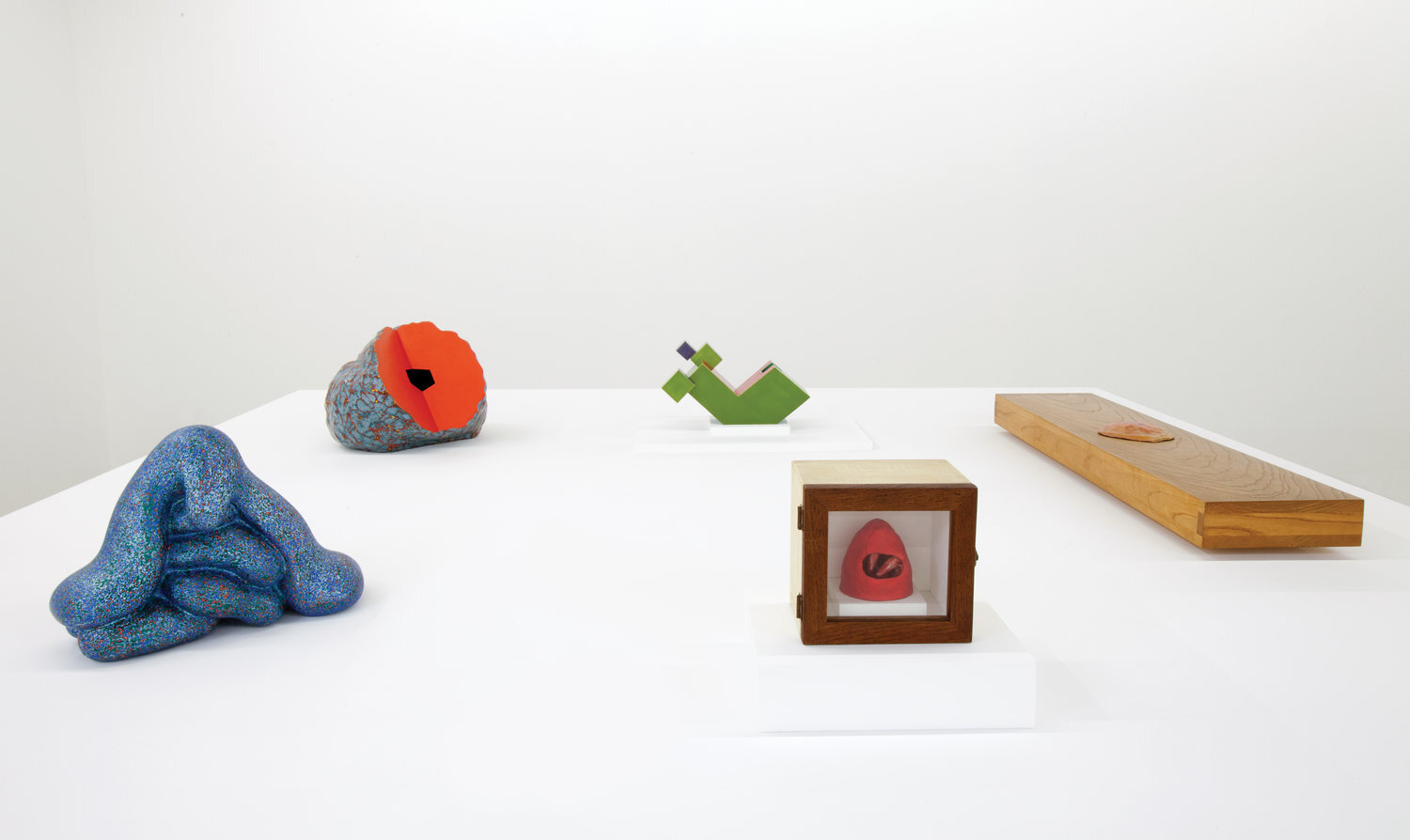Ken Price: A Career Survey, 1961- 2008
January 29 - March 8, 2016
View of “Ken Price,” 2016. From left: The Slouch, 2005; Rebuncular, 1988; Untitled (Geometric), 1980; Untitled (Red Mound), 1960–61; Untitled, 1967–69.
KEN PRICE: A CAREER SURVEY, 1961 - 2008
January 29th - March 8th, 2016
The inaugural exhibition at Parrasch Heijnen Gallery was clearly the result of a herculean effort. Not for nothing was the show titled “Ken Price: A Career Survey, 1961–2008”; its ambition and temporal spread rivaled the artist’s 2012–13 touring show, which originated at the Los Angeles County Museum of Art. While the latter assembled considerably more objects than were on view here, this retrospective, economic in its selections, nevertheless demonstrated the fecundity of Price’s continual sculptural redefinitions, while hewing to the media in which his material and procedural experimentation took such exemplary form. (Franklin Parrasch, who curated the show, cherry-picked twenty-four works running the gamut from those exhibited in Price’s first outings at the Ferus Gallery in LA in the early 1960s to late pieces from the past decade, pointedly refraining from including a single work from the previous survey.) And while LACMA presented its show in chronological order, Parrasch eschewed a linear installation, instead outfitting the new space’s main room with four wide table-like plinths, each of which supported a set of small-scale ceramic sculptures that cut across the artist’s career in a lateral democracy. The groups included a mix of decades, and an emphasis on the range of Price’s oeuvre seemed very much the curatorial intention.
The front-left plinth alone offered a gernerous assortment: the iridescent S.D. Violet, 1967, with its irregularly protruding lozenge-like appearance; Untitled (Two Part Geometric), 1974, with its Bauhaus-esque primary palette and boxy geometry; the vibrant and jaggedly striated Untitled (Rock), 1984; the dappled Whisper, 1997, with its Möbius-strip-like continuity; and the totemic Deuce, 2004, its upright form melting into bulbous legs. Despite this heterogeneity, Price’s work was revealed to be productively recursive, with certain aspects manifesting more than once in varying guises. Three late-’60s cups—one with three legs, another with an emerald frog grasping its base, and a third with a snail poised to circumambulate it—together highlighted differentiation within a standardized format. More broadly, multiple blob-like, biomorphic sculptures looked as though they were arrested mid-seepage. Many of Price’s works harbor central cavities or voids. Color plays a primary role within these works. Whisper and Deuce both appear to be blanketed in pointillist atoms, although “blanketed” isn’t exactly right, because these sculptures are constituted by that treatment as much as they are draped by it. Indeed, Price posits more emphatically than most the relation between surface and form, and explores the ways in which color can reside on the surface or penetrate it, depending on the physical processes of firing.
For all their diversity, the works Parrasch selected were without exception ceramics. In this, the survey maintained the more recent historiographic emphasis on Price as a clay-based artist. It must be kept in mind, however, that Price’s chosen medium had in previous decades limited his work’s circulation and reception. Price—like Peter Voulkos, with whom he studied—was an artist who made pottery within an expanding but very different art world than that of the present, a sphere wide enough to absorb work in all media. Yet the point here was less the obviation of distinctions between craft and fine art, codependent terms and moving targets anyhow, than the proposition that a focused logic could yield a potent range of outcomes through the mastery of obdurate stuff (as well as through the unforeseen exigencies arising from their making). Price was the subject of only one museum survey in his lifetime (at the Menil Collection in Houston in 1992), a fact all the more surprising in retrospect given how fresh his pieces appeared in this showing. Diminutive and fashioned out of earth, occult in their reference and campy in their embrace of a Technicolor world around them, these totems were once outliers. That time feels increasingly distant.
Press:


